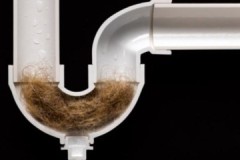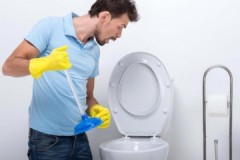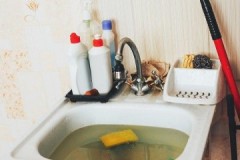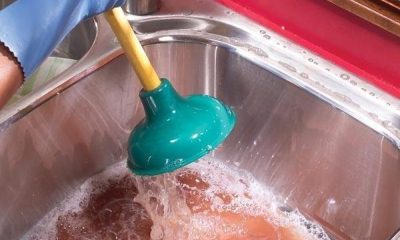 A clogged pipe is an unpleasant surprise that literally stops life in your home.
A clogged pipe is an unpleasant surprise that literally stops life in your home.
You can try to dissolve it with improvised or store-bought means, or push it mechanically, but first you need to understand exactly where it is located and how it was formed.
Detailed instructions on how to clear a blockage in a pipe are described in the article.
Content
Causes of the problem
Blockages can form in both plastic and metal pipes. The older the drainage system, the higher the likelihood that an obstacle will form in the way of water outflow.
Reasons for appearance:
- accumulation of food waste, hair, paper and other organic and inorganic debris;
 fatty deposits that stick to the walls of the pipe and collect small debris;
fatty deposits that stick to the walls of the pipe and collect small debris;- limescale deposits formed due to too hard water and impurities in it;
- foreign objects, such as rags, falling into the drain hole;
- improper installation of the drainage system;
- mechanical damage to pipes.
It is not possible to be 100% insured against a blockage; it can occur even in the most careful people who monitor the condition of the pipes and regularly carry out preventive cleaning.
How to determine its location and type?
Most often, sewerage becomes clogged in siphons and at the junction of pipes with angles and tees. Blockages are divided into three types:
- Local, in which water stagnates in only one place, for example, in the bathtub or sink.
- General, when there is water in both the bathroom and the sink.
- Global, in which the liquid does not pass through all the pipes.
Local blockage can be determined without problems, since most often it is concentrated in the place of the water seal of the plumbing fixture, that is, in the siphon area.
Finding the location of a common blockage is also easy. For example, if there is water in the sink and in the bathroom, but leaves the toilet well, then it has formed in the lounger in the area between the bathroom and the toilet.
A global blockage blocks the entire sewer drain at the farthest point. This is the most serious problem, which often requires calling a specialist. He will determine the location of the blockage using a flexible tube with a camera at the end.
If this happens after 2-5 seconds, then the siphon or the area closest to it is clogged. When the plug is further away, it takes a little longer for the water to flow into the pipe. The obstruction of the common riser is indicated by rising water in all plumbing fixtures in the apartment.
The following types of blockages are distinguished:
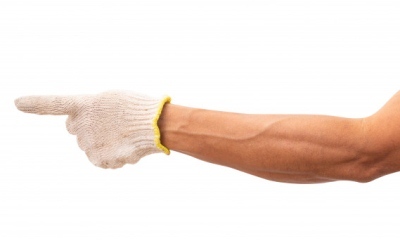 Operational with localization in the pipe, in which it becomes clogged with food debris, hair, dust, and grease. These substances inevitably end up in the drain in any apartment.
Operational with localization in the pipe, in which it becomes clogged with food debris, hair, dust, and grease. These substances inevitably end up in the drain in any apartment.- Operational with localization in the siphon. Most often it is represented by small debris.
- Mechanical. It can occur unexpectedly, for example, when large debris gets in, or gradually, when it slowly and systematically accumulates inside the pipe.
- Technogenic. This blockage is due to errors made in the design of the drainage system.
How to eliminate with folk remedies at home?
You can get rid of the blockage using improvised means. Recipe No. 1 in the fight against traffic jams is a combination of soda and vinegar. You need to proceed as follows:
- 200 g of baking soda are poured into the drain hole;
- pour 200 ml of table vinegar into the pipe;
- cover the hole with old rags and leave for 15 minutes;
- turn on the hot water and rinse the pipe under high pressure.
This method will allow you to cope with fatty deposits that are located in the immediate vicinity of the entrance to the drain hole. Will tell you more details this article.
Caustic soda is used as a mono-remedy; it is not combined with sting or other chemicals.
Procedure:
- 1 kg of soda and 6 liters of water are dissolved in a metal container.
- Stir the composition until the bulk substance is completely dissolved.
- Place a bucket or basin on the fire and bring it to 70 degrees; the liquid should not boil.
- Slowly pour half the solution into the pipe. Leave for 2 hours, then rinse with clean hot water for 10 minutes.
- Heat the remaining composition again and repeat the procedure.
This method of using caustic soda allows you to deal with blockages the first time.
The blockage can be formed not only by organic substances, but also by lime deposits.This problem is more typical for metal pipes. You can deal with such a traffic jam using citric acid.
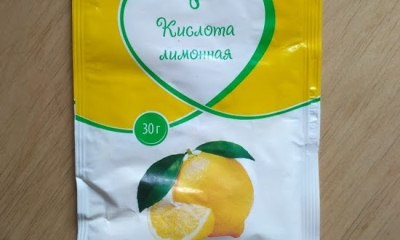 Mode of application:
Mode of application:
- 100 g of citric acid is poured into the drain hole;
- pour 200 ml of hot water there;
- close the drain with a rag or stopper and leave for half an hour;
- turn on the hot water and flush the pipes.
If the water does not pass completely the first time, the procedure is repeated.
Washing powder will help deal with clogs caused by organic matter and dirt. By enveloping the smallest particles in a soap film, it promotes their movement into the drains.
Procedure:
- 100 g of washing powder is poured into the drain hole.
- Pour 500 ml of hot water into it.
- Leave for 30 minutes.
- Flush the pipes under high pressure.
You can get rid of the unpleasant odor and clean the drain hole using Alka-Seltzer anti-hangover tablets. They are used as follows:
- crush the tablets into powder;
- pour it into the drain hole;
- pour 200 ml of table vinegar and 50 ml of water inside;
- cover the drain with a rag;
- After 10 minutes, rinse the pipe with hot water.
How to quickly remove with special compounds?
If folk remedies do not help solve the clog problem, you can turn to household chemicals. There is a wide range of pipe cleaners available in stores. To choose the right composition that will not harm the water supply, you need to take into account the following points:
-
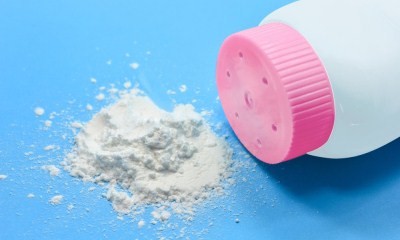 Powders. They are represented by highly concentrated acids and alkalis.They are poured into the drain, filled with a small amount of water and left overnight.
Powders. They are represented by highly concentrated acids and alkalis.They are poured into the drain, filled with a small amount of water and left overnight.In the morning the pipes are washed. The advantage of such products is the low price, and the disadvantage is the inconvenience of use.
When poured into a drain, some of the powder may spill out, harm plumbing fixtures and damage rubber gaskets.
In addition, if you pour too much water into the pipe, the powder will simply be washed away into the general drain, and the blockage will remain in place. This often happens when dirt narrows the opening of the pipe rather than blocking it.
- Liquid products. They are represented by less concentrated solutions of acids and alkalis. They are simply poured into the pipe and left to act for the time specified in the instructions. Such compositions are more expensive than powders, but they are more convenient to use. However, if water remains in the pipe, it will reduce the concentration of the substance, and it will be ineffective.
- Gels. They are poured into the pipe, left for a while and washed off with clean water. Due to their viscous consistency, they stay inside longer, so they dissolve blockages more effectively. These are the most effective, but also the most expensive formulations.
When choosing a product, you need to carefully study the label to clarify what type of pipes it is suitable for. The composition may contain alkalis, acids, surfactants and flavors. By reacting with deposits, the active substances dissolve them, promoting cleansing.
Top 3 best drugs
Effective pipe cleaners:
Sanfor gel
Gel for pipes, for complex blockages.The composition is suitable for processing any pipes, helps eliminate odors, kill bacteria, contains chlorine. Price – 100 rubles.
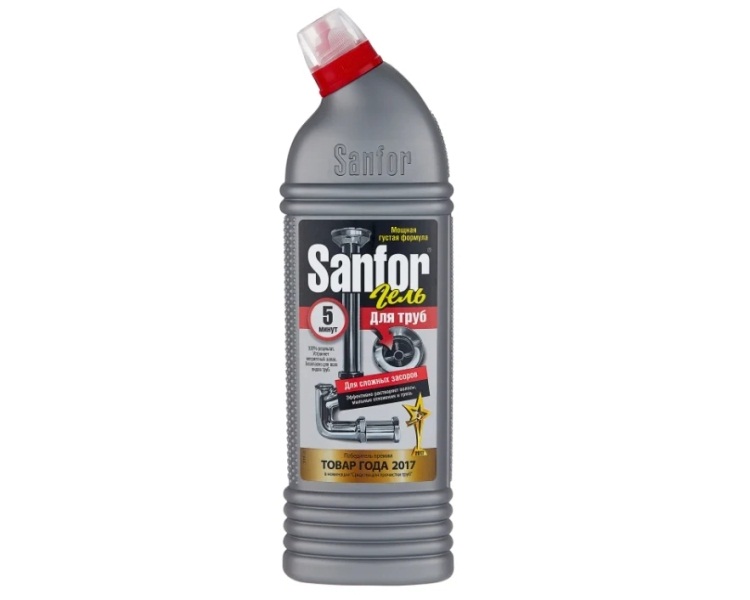
How to clean pipes with Bagi Pothan granules?
The product is safe for metal and plastic pipes and effectively dissolves grease and hair. For one treatment, use 100 g of granules and 100 ml of hot water. Exposure time – 3 minutes. Price – 450 rubles.

Mole Turbo
The product cleans and disinfects pipes, helps eliminate unpleasant odors and treats surfaces antibacterially. Contains chlorine. Price 120 rubles.
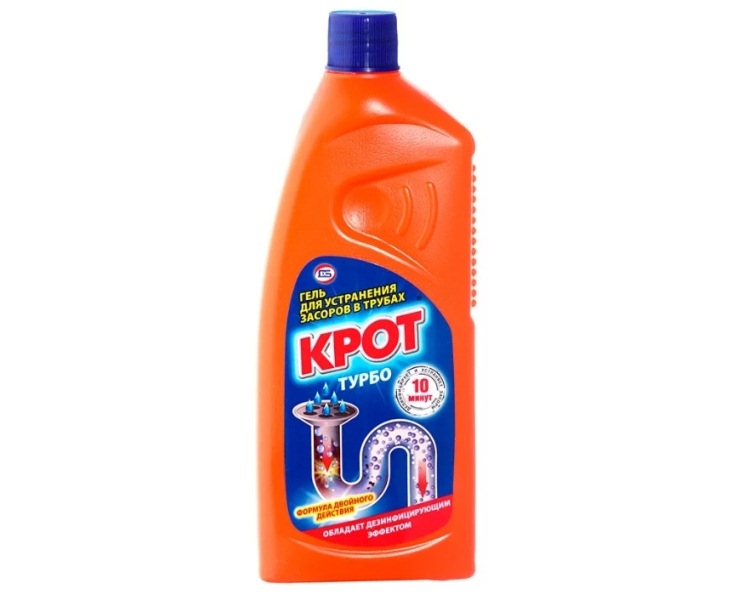
How to remove a strong one?
If folk and store-bought formulations are powerless in the fight against blockage, they resort to radical cleaning methods. Possible options:
- Vacuum cleaner. A technique that can not only blow in, but also blow out air is suitable. It is this function that will be useful in the fight against blockages. The tube is wrapped in thick material, leaned against the drain hole and the vacuum cleaner is turned on at full power. The air flow will push the clog down the drain.
- Plunger. Pour water into the drain, press the plunger against it and actively work with your hands, pressing and lifting the handle. Pressure will build up inside the pipe, causing the clog to move forward.
- Cable. If the plug is deep, or is completely fixed in the bend of the pipe, use a plumbing cable to catch the blockage and pull it out. First you will have to dismantle the siphon.
The cable is inserted into the pipe and rotated clockwise, slowly moving its tip forward. Having reached the blockage, it is slowly broken through and removed out along with the cable. The pipe is washed with plenty of warm water.
After radical cleaning, you can resort to using improvised or store-bought products.
Read about how to clear a clogged toilet. Here, in the sink - here, in the kitchen sink - in this article, in a sewer pipe - in this.
When should you call a plumber?
If you are unable to deal with the blockage on your own, you need to call a plumber. You can’t do without his help when there is a traffic jam formed in the toilet drain.. A specialist will also be required if a persistent unpleasant odor appears from the pipe, which cannot be dealt with with chemicals.
Prevention
To reduce blockages in pipes, preventive measures must be taken regularly:
- wash dishes in warm, not cold water - hot liquid dissolves fat, preventing it from sticking to the walls;
- install a mesh that will trap food particles, hair and other contaminants;
- leftover food from dishes should be thrown into a bucket and not poured down the drain;
- once every 14 days you should rinse the pipes with hot water for half an hour;
- Once a month, use baking soda or other available means to flush drains.
What should you not do and why?
Recommendations that should not be violated:
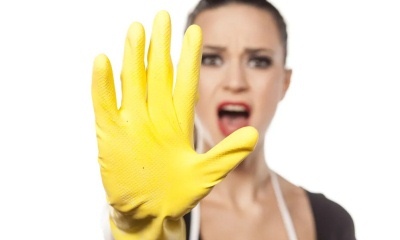 You cannot start work without personal protective equipment. Caustic substances can dissolve not only clogs, but also cause chemical burns.
You cannot start work without personal protective equipment. Caustic substances can dissolve not only clogs, but also cause chemical burns.- It is not recommended to pour boiling water into plastic pipes. The water should be no higher than 70 degrees.
- You cannot pour sulfuric acid into the drain in its pure form, it will damage the drain.
- It is recommended to use a special plumbing tool to clean pipes.Improvised means in the form of wire can ruin plumbing fixtures.
Helpful information
Removal Recommendations blockages:
- to effectively flush the pipes after dissolving the blockage, you can use a shower - remove the watering can from it and direct the hose into the drain hole;
- When using a plunger to clean pipes, lubricate its edges with Vaseline or grease - this will ensure its tight fit to the surface;
- After adding the cleaning solution to the drain, you should not lean towards it and inhale the released vapors;
- You need to carefully clean plastic pipes with a cable - burrs and scratches will lead to the formation of new blockages.
Conclusion
You can get rid of the blockage using improvised and specialized means, or mechanically. To choose an effective method, you need to determine the type of blockage and its location. If you can’t cope on your own, you need the help of a plumber.
